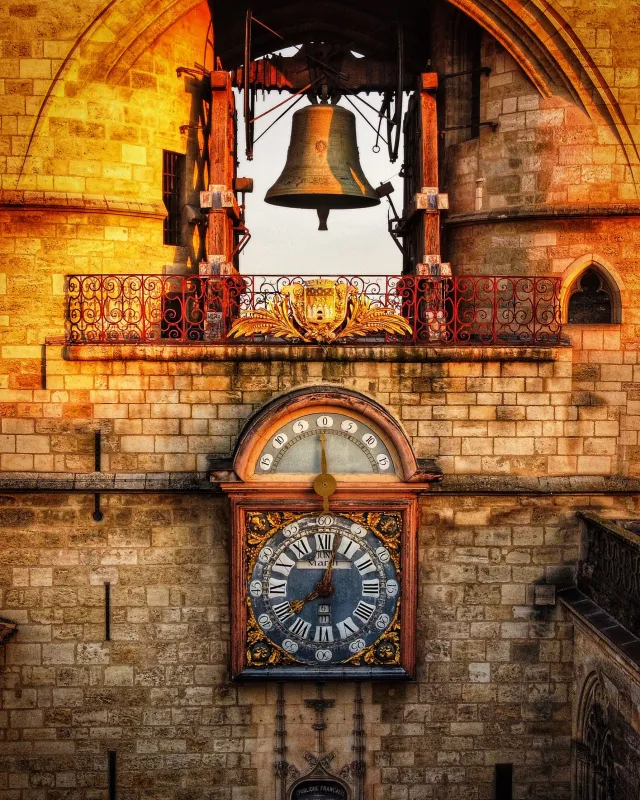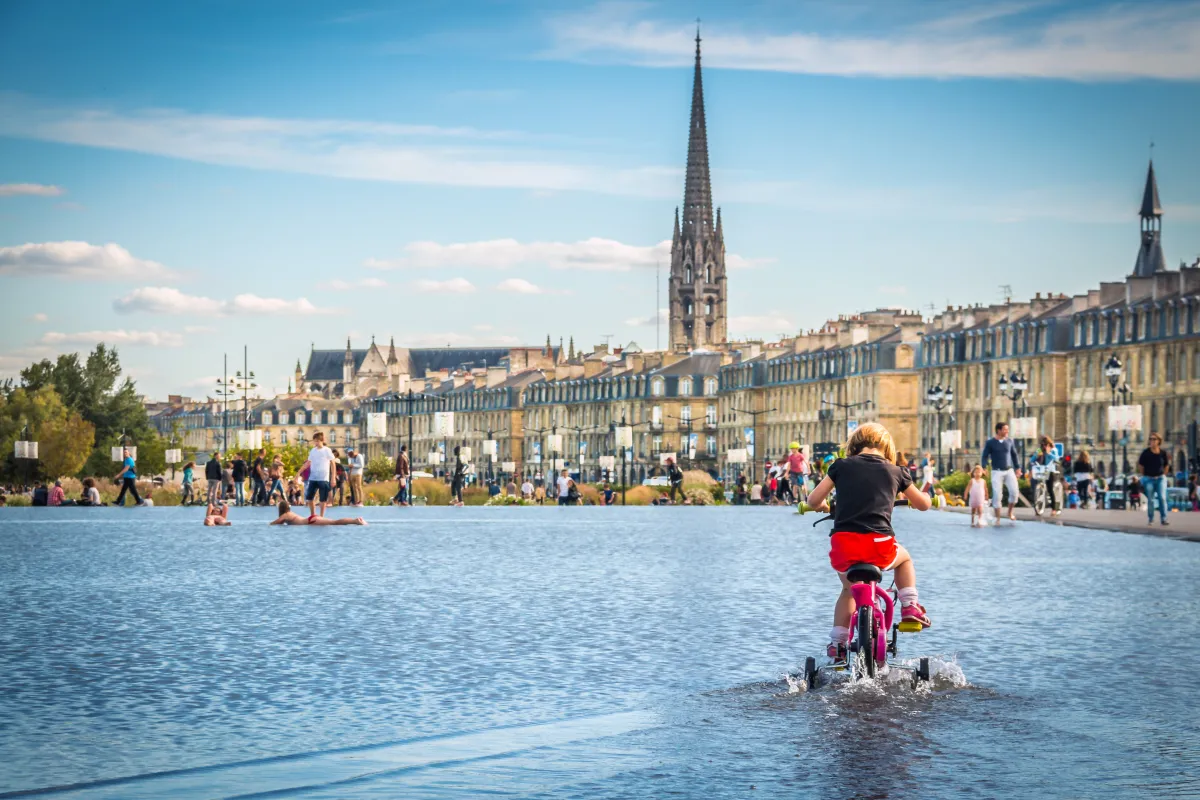
Accessible route : The "Port de la Lune" circuit
Come and discover the largest urban area to be awarded the Unesco. Bordeaux has 1,810 hectares classified as World Heritage. This tour links the city's main monuments and historic districts. The tour has been awarded the Tourism & Handicap label (for hearing, physical and intellectual impairments).
With your mobile phone, follow the route in real time:
- No need for a specific application
- Simply activate the geolocation via the icon on the map
You can collect this route in paper format at the Bordeaux Tourist Office: 12 Cr du 30 Juillet, 33000 Bordeaux.
Steps
The starting point for of this tour is the Bordeaux Tourist Office. Located at 12 cours du XXX juillet, you can get there by tram by stopping at "Quinconces". This beautiful building was built around 1820. Certified Tourism & Handicap for the 4 families of handicap, it is in this building that you can buy your City Pass, which allows you to visit several monuments included in this walk.
Created by Victor RICH, this monument pays tribute to the Girondin deputies who were victims of the Terror. At the top of the 43-metre column you will find Liberty breaking its chains. Retrace your steps towards the Gobineau's House.
This establishment, which is nowadays home to the Maison du Vin de Bordeaux, was designed by the architect of the Grand-Théâtre. Its facade makes it special. Go up the street to the Grand-Théâtre.
You are facing one of the most mythical monuments of Bordeaux. The Grand-Théâtre. Designed by Victor Louis, this building is 88 metres long and 47 metres wide and is preceded by a portico with twelve statues: the nine muses along with Minerva, Venus and Juno. It is nowadays the city's national opera house. Take the Cours de l'Intendance on the right-hand side.
This hotel with a neo-classical architecture style is known in particular for the two small statues on the façade of the building. You can see 2 small marine geniuses in a half round shape with their backs to the wall, their necks bent forward, their arms resting on the arches. Take the first street on the right and then turn left into rue Diderot. Warning: Frequent traffic. Paved road. Pavements often crowded.
Built by the Jacobins, the Notre-Dame church is characteristic of the buildings of the Counter-Reformation. Pierre Duplessy-Michel was the architect.
This courtyard is part of the former Dominican convent. It is now of the Regional Chamber of Accounts' headquarters and is also used for exhibitions. Go around the Place des Grands Hommes on the left. Then take rue Montesquieu and continue on Condillac street and Vieille Tour street.
Designed by Michel Voisin, this gate is one of the monumental entrances to the town built in the 18th century. Continue along the rue des Remparts. At the end of the street, take the pedestrian passage, then walk along the Palais Rohan.
This majestic palace located on the Place Pey Berland has been since 1837 the Bordeaux's City Hall. This palace used to be the prefecture of the Gironde, and became the imperial palace and royal residence until 1837.
On this magnificent Pey Berland square you will also find the imposing Cathedral of Saint André. Its construction began in the 12th century and was completed in the 16th century. Right next to it, the Pey Berland tower was built in the 15th century. The City Pass allows you to visit the interior of the tower. Take the pedestrian crossing at the intersection of the tramway tracks to reach the Cours d'Alsace-Lorraine. Immediately take the pedestrian crossing on the right to get to Duffour Dubergier street.
Designed to house the Faculty of Science and Letters, the building has been home to by the Musée d'Aquitaine since 1987. The permanent collections retrace the history of Aquitaine and more particularly of Bordeaux, from prehistoric times to the present. This museum has been awarded the Tourism & Handicap label for the 4 types of impairments and a visit is included in the City Pass. The museum is not open on Mondays and on public holidays. Take Cours Victor Hugo and then street Saint-James. Continue to Place Fernand-Lafargue.
The only remnant of the 13th century defensive wall. Cast in 1775 by the founder Turmel, the bell weighs 7,800 kg. It rings five times a year : on January 1st, May 8th, July 14th, August 28th (commemoration of the Liberation of Bordeaux in 1944) and November 11th. Go straight ahead to the Place Fernand Lafargue.
This square used to be the site of the great Bordeaux market. Today it is home to the pillory, represented by a 10m high hexagonal tower. Go along the rue Sainte-Colombe. Turn left into rue Chapelle Saint-Jean. Take the pedestrian passage and go to the Place du Palais.
This square was linked to the former Palais de l'Ombrière (12th-18th centuries). It showcases a group of buildings with facades from the 17th to the 19th century. Opposite you, you will find the Cailhau gate.
Old defensive gate (1493-1496) dedicated to King Charles VIII, victor of the battle of Fornoue (Italy). The building is certainly military, equipped with a portcullis and crowned with heavy machicolations, but the Renaissance period brings a new architectural language : mullioned windows, sculpted decoration. This building can be visited with the City Pass. Then take the Argentiers street to get to Place Saint-Pierre.
This is a fine example of a bourgeois building built around 1760, which nowadays welcomes pilgrims on their way to Santiago de Compostela. Head towards St Peter's Square.
Built during the 14th and 15th centuries, and remodelled in the 19th century, this church was built on the site of the old Gallo-Roman port. Turn left into Parlement Saint-Pierre street. Walk along the Place du Parlement to reach the Lauriers street on the right.
This square was created in 1754 by decision of the Intendant Tourny. It was intended to house a market. In the centre stands a fountain created by Louis Garros (1865). At the intersection, turn right into street Saint-Rémi.
You are now on the iconic square of Bordeaux. The Place de la Bourse was commissioned by Intendant Boucher. The beauty of this square lies in its openness to the Garonne and its architecture.
On the same square, you will find the Fountain of the 3 Graces. This fountain was created by Gumery in 1865 after a drawing by Louis Visconti.
This is where all goods arriving at the port were registered. It is now the National Customs Museum. It can be visited with the City Pass.
The Miroir d'eau was built as part of the redevelopment of the Garonne quays. It is the largest water mirror in the world (3,450 m²). This enchantment created by the fountain designer Jean-Max Llorca offers a refreshing stopover in summer. Walk along the Place de la Bourse on the left to reach the Place Jean Jaurès.
Designed by the architect Jacques-Anges Gabriel, the Palais de la Bourse was built from 1745 to 1748. The Place de la Bourse royale became, with this Hôtel de la Bourse, the place where the price of goods was set in the 18th century. Walk along the Place Jean Jaurès. Then take the pedestrian passage to reach the Cours du Chapeau-Rouge.
This hotel, whose architect was Victor Louis, is famous for its spiral and empty core staircase. This building only accepts outdoor visits. Go up the Cours du Chapeau-Rouge by the central alley. Turn right to return to the starting point.
Also designed by Victor Louis, this hotel is inspired by the Mancini Palace in Rome.
Built in 1608 and planned by Henri Roche, this hotel is a rare example of Bordeaux architecture under the reign of Henri IV.
The tour ends in front of the Grand Theatre. We hope you have enjoyed this tour.
Points of Interest (POI)
There is a car park here if you come by car. It is a one minute walk/wheelchair ride from the first stage.
Here you can find the parking spaces in the streets closest to the first stage. You are 3 minutes away from the first stage by foot / wheelchair.
The restaurant Le Bordeaux will offer you a quality service and cuisine. These refined dishes, cooked with local products, will satisfy you. The restaurant is accessible to people with reduced mobility. Learn more.
The Karl offers brunch every day. They also have a wide choice of teas, pastries, salads... The restaurant is accessible to people with reduced mobility. Learn more.
Next to Saint-André Cathedral, you can sit down at the "Café Rohan" restaurant, which has an extensive menu. This restaurant has been awarded the Tourism & Handicap label for the 4 families of disabilities (hearing, mental, motor and visual). Learn more.































